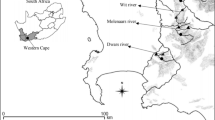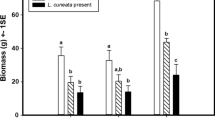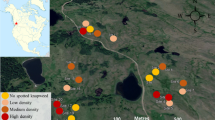Abstract
Disturbances, such as flooding, play important roles in determining community structure. Most studies of disturbances focus on the direct effects and, hence, the indirect effects of disturbances are poorly understood. Within terrestrial riparian areas, annual flooding leads to differences in the arthropod community as compared to non-flooded areas. In turn, these differences are likely to alter the survival, growth, and reproduction of plant species via an indirect effect of flooding (i.e., changes in herbivory patterns). To test for such effects, an experiment was conducted wherein arthropod predators and herbivores were excluded from plots in flooded and non-flooded areas and the impact on a common riparian plant, Mimulus guttatus was examined. In general, the direct effect of flooding on M. guttatus was positive. The indirect effects, however, significantly decreased plant survival for both years of the experiment, regardless of predator presence, because of an increased exposure to grasshoppers, the most abundant herbivore in the non-flooded sites. Leafhoppers, which were more abundant in the flooded sites, had much weaker and varying effects. During 2000, when the leafhopper herbivory was high, arthropod predators did not significantly reduce damage to plants. In 2001, the mean herbivory damage was lower and predators were able to significantly reduce overall leafhopper damage. The effects of predators on leafhoppers, however, did not increase plant survival, final weight, or the reproduction potential and, thus, did not initiate a species-level trophic cascade. Overall, it was the differences in the herbivore community that led to a significant decrease in plant survival. While flooding certainly alters riparian plant survival through direct abiotic effects, it also indirectly affects riparian plants by changing the arthropod community, in particular herbivores, and hence trophic interactions.






Similar content being viewed by others
References
Caicco SL (1998) Current status, structure, and plant species composition of the riparian vegetation of the Truckee River, California and Nevada. Madroño 45:17–30
Canales J, Trevisan MC, Silva JF, Caswell H (1994) A demographic study of an annual grass (Andropogon brevifolius Schwarz) in burnt and unburnt savanna. Acta Oecologica 15:261–273
Carson WP, Root RB (2000) Herbivory and plant species coexistence: community regulation by an outbreaking phytophagous insect. Ecol Monogr 70:73–99
Collins SL (2000) Disturbance frequency and community stability in native tallgrass prairie. Am Nat 155:311–325
Day RT, Keddy PA, McNeil J, Carleton T (1988) Fertility and disturbance gradients: a summary model for riverine marsh vegetation. Ecology 69:1044–1054
DeLong DM (1971) The bionomics of leafhoppers. Annu Rev Entomol 16:179–210
Dempster JP (1963) The population dynamics of grasshoppers and locusts. Biol Rev 38:490–529
Diamond J (1986) Overview: laboratory experiments, field experiments, and natural experiments. In: Diamond J, Case TJ (eds) Community ecology. Harper and Row, New York, pp 65–79
Doak DF (1992) Lifetime impacts of herbivory for a perennial plant. Ecology 73:2086–2099
Elderd BD (2003) Changing flow regimes: its impacts on riparian vegetation and a common riparian species, Mimulus guttatus. Ecol Appl 13:1610–1625
von Ende CN (1993) Repeated-measures analysis: growth and other time-dependent measures. In: Scheiner SM, Gurevitch J (eds) Design and analysis of ecological experiments. Chapman & Hall, New York, pp 113–137
Fine PVA, Mesones I, Coley PD (2004) Herbivores promote habitat specialization by trees in Amazonian Forests. Science 305:663–665
Framenau VW, Manderbach R, Baehr M (2002) Riparian gravel banks of upland and lowland rivers in Victoria (south-east Australia): arthropod community structure and life-history patterns along a longitudinal gradient. Aust J Zool 50:103–123
Grant AL (1924) A monograph of the genus Mimulus. Ann Mo Bot Gard 11:99–389
Hairston NG (1989) Ecological experiments: purpose, design, and execution. Cambridge University Press, Cambridge
Halaj J, Wise DH (2001) Terrestrial trophic cascades: how much do they trickle? Am Nat 157:262–281
Hewitt GB (1979) Hatching and development of rangeland grasshoppers in relation to forage, growth, temperature, and precipitation. Environ Entomol 8:24–29
Hewitt GB (1985) Review of factors affecting fecundity oviposition, and egg survival of grasshoppers in North America. US Department of Agriculture Agricultural Research Service, Washington, p 35
Hickman JC (ed) (1993) The Jepson manual: higher plants of California. University of California Press, Berkeley
Hobbs RJ, Mooney HA (1991) Effects of rainfall variability and gopher disturbance on serpentine annual grassland dynamics. Ecology 72:59–68
Holling CS (1959) The components of predation as revealed by a study of small mammal predation of the European pine sawfly. Can Entomol 91:293–320
Huntly N (1991) Herbivores and the dynamics of communities and ecosystems. Annu Rev Ecol Syst 22:477–503
Knight TM, Holt RD (2005) Fire generates spatial gradients in herbivory: an example from a Florida sandhill ecosystem. Ecology 86:587–593
Lenssen JPM, de Kroon H (2005) Abiotic constraints at the upper boundaries of two Rumex species on a freshwater flooding gradient. J Ecol 93:138–147
Lindsay DW (1964) Natural dispersal of Mimulus guttatus. Proc Utah Acad 41:237–241
Louda SM (1982) Distribution ecology: variation in plant recruitment over a gradient in relation to insect seed predation. Ecol Monogr 52:25–41
Lude A, Reich M, Plachter H (1999) Life strategies of ants in unpredictable floodplain habitats of alpine rivers (Hymenoptera: Formicidae). Entomol Gen 24:75–91
Milford ER (1999) Ant communities in flooded and unflooded riparian forest of the middle Rio Grande. Southwest Nat 44:278–286
Neter J, Kutner MH, Nachtsheim CJ, Wasserman W (1996) Applied linear statistical models. McGraw-Hill, Boston
Olff H, Ritchie ME (1998) Effects of herbivores on grassland plant diversity. Trends Ecol Evol 13:261–265
Paine RT, Levin SA (1981) Intertidal landscapes: disturbance and the dynamics of pattern. Ecol Monogr 51:145–178
Pascarella JB, Horvitz CC (1998) Hurricane disturbance and the population dynamics of a tropical understory shrub: megamatrix elasticity analysis. Ecology 79:547–563
Rand TA (2002) Variation in insect herbivory across a salt marsh tidal gradient influences plant survival and distribution. Oecologia 132:549–558
Reich M (1991) Grasshoppers (Orthoptera, Saltatoria) on alpine and dealpine riverbanks and their use as indicators for natural floodplain dynamics. Regul Rivers: Res Manage 6:333–339
Risch SJ, Carrol CR (1982) Effect of a keystone predaceous ant, Solenopsis geminata, on arthropods in a tropical agroecosystem. Ecology 63:1979–1983
Root RB, Cappuccino N (1992) Patterns in population change and the organization of the insect community associated with goldenrod. Ecol Monogr 63:393–420
SAS Institute Inc. (1999) Version 8.00. SAS Institute Inc., Cary
Savage W (1973) Annotated check-list of vascular plants of Sagehen creek basin, Nevada County, California. Madroño 22:115–139
Scheiner SM (1993) MANOVA: multiple response variables and multispecies interactions. In: Scheiner SM, Gurevitch J (eds) Design and analysis of ecological experiments. Chapman & Hall, New York, pp 94–112
Schmitz OJ, Beckerman AP, O‘Brien KM (1997) Behaviorally mediated trophic cascades: effects of predation risk on food web interactions. Ecology 78:1388–1399
Shafroth PB, Stromberg JC, Patten DT (2002) Riparian vegetation response to altered disturbance and stress regimes. Ecol Appl 12:107–123
Silvertown J, Dodd ME, Gowing DJG, Mountford JO (1999) Hydrologically defined niches reveal a basis for species richness in plant communities. Nature 400:61–63
Sousa W (1979) Disturbance in marine intertidal boulder fields: the nonequilibrium maintenance of species diversity. Ecology 60:1225–1239
Strong DR (1992) Are trophic cascades all wet? Differentiation and donor-control in speciose ecosystems. Ecology 73:747–754
Townsend PA (2001) Relationships between vegetation patterns and hydroperiod on the Roanoke River floodplain, North Carolina. Plant Ecol 156:43–58
Underwood AJ (1990) Experiments in ecology and management: their logics, functions, and interpretations. Aust J Ecol 15:365–389
Underwood AJ (1997) Experiments in ecology: their logical design and interpretation using analysis of variance. Cambridge University Press, Cambridge
Vickery RK Jr (1978) Case studies in the evolution of species complexes in Mimulus. Evol Biol 11:405–506
White PS, Pickett STA (eds) (1985) The ecology of natural disturbance and patch dynamics. Academic Press, San Diego
Wootton JT, Parker MS, Power ME (1996) Effects of disturbance on river food webs. Science 273:1558–1561
Acknowledgments
The author would like to thank D. Doak, G. Dwyer, J. Kluse, T. Miller, I. Parker, the Dwyer lab, and two anonymous reviewers for their helpful comments and suggestions on this manuscript. R. Gillis, B. Vogel, and P. Ward graciously agreed to identify the arthropod and insect species and I appreciate their help. I would also like to thank J. Jacobs, P. Kaniewska, and H. Talbot for their help in the field and J. Velzy and L. Locatelli for their advice and help in the greenhouse. Additionally, I would like to express my gratitude to J. Brown, F. Felix, J. Schifini, and W. Schifini as well as Nüt and Buster for providing an excellent research environment at Sagehen Creek. This work was supported by a NSF-IGERT grant (GER-9553614), a Mazamas Research Grant, and the Department of Environmental Studies.
Author information
Authors and Affiliations
Corresponding author
Additional information
Communicated by Thomas Miller
Rights and permissions
About this article
Cite this article
Elderd, B.D. Disturbance-mediated trophic interactions and plant performance. Oecologia 147, 261–271 (2006). https://doi.org/10.1007/s00442-005-0267-1
Received:
Accepted:
Published:
Issue Date:
DOI: https://doi.org/10.1007/s00442-005-0267-1




